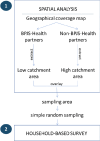What are the factors affecting primary care choice when the access under health insurance scheme is limited?: a cross-sectional study in Bandung, Indonesia
- PMID: 38383314
- PMCID: PMC10882734
- DOI: 10.1186/s12875-024-02296-6
What are the factors affecting primary care choice when the access under health insurance scheme is limited?: a cross-sectional study in Bandung, Indonesia
Abstract
Background: Ensuring equal access to primary care services is crucial, as the gateway to a higher level of care. Indonesia has been trying to increase financial access to medical care by administering national health insurance known as BPJS-Health (Badan Penyelenggara Jaminan Sosial Kesehatan) since 2014. However, BPJS-Health beneficiaries can only use their benefits at a limited number of registered primary care providers (BPJS-Health partners). This study investigated the geographical coverage of BPJS-Health and BPJS-Health beneficiaries' primary care choices, based on their characteristics and healthcare preferences in the target areas of Bandung, Indonesia.
Methods: The setting of this cross-sectional study was the areas with low physical access to BPJS-Health partners but high physical access to non-BPJS-Health partners. Physical access was determined by spatial network analysis, resulting in a geographical coverage map. A total of 216 adults were recruited and they completed the questionnaire about their primary care choice. All participants had been registered with the BPJS-Health system and living in the study areas. Their participation in non-BPJS-Health was also evaluated. Participants' choice of care was assessed in three different scenarios, when the individual was experiencing mild, chronic, and serious illnesses.
Results: BPJS-Health partners' geographical coverage was unequally distributed in Bandung. Being registered with non-BPJS-Health company was negatively associated with the more frequent choice of using BPJS-Health partners' services (AOR = 0.18; 95% CI, 0.06-0.58, P = 0.004) among BPJS-Health beneficiaries. For serious illnesses, having a high income was associated with choosing non-BPJS-Health partners and hospitals (AOR = 4.90; 95% CI, 1.16-20.77, P = 0.031). When dealing with mild and chronic illnesses, participants were concerned about the quality of treatment they would receive as a major factor in choosing a primary care provider. However, receiving better treatment quality was negatively associated with choosing BPJS-Health partners in all cases of illness severities.
Conclusions: Sociodemographic characteristics, healthcare preference factors, and health insurance status were associated with participants' primary care choices in the target areas of Bandung, Indonesia. BPJS-Health partners' coverage map and the preference factors are potentially important for policymakers, especially for the development of future BPJS-Health partnerships.
Keywords: Choice; Health insurance; Preference; Primary care; Spatial network analysis.
© 2024. The Author(s).
Conflict of interest statement
The authors declare no competing interests.
Figures




Similar articles
-
Availability and Accessibility of Primary Care for the Remote, Rural, and Poor Population of Indonesia.Front Public Health. 2021 Sep 21;9:721886. doi: 10.3389/fpubh.2021.721886. eCollection 2021. Front Public Health. 2021. PMID: 34621720 Free PMC article.
-
Correlation between economic status and severity of type 2 diabetes mellitus in Indonesia: analysis of claim data from the national health insurance scheme, 2018-2022.BMJ Open. 2025 May 2;15(5):e091115. doi: 10.1136/bmjopen-2024-091115. BMJ Open. 2025. PMID: 40316359 Free PMC article.
-
Understanding the impacts of NPM and proposed solutions to the healthcare system reforms in Indonesia: the case of BPJS.Health Policy Plan. 2020 Apr 1;35(3):346-353. doi: 10.1093/heapol/czz165. Health Policy Plan. 2020. PMID: 31965166
-
Temperature and non-communicable diseases: Evidence from Indonesia's primary health care system.Health Econ. 2022 Nov;31(11):2445-2464. doi: 10.1002/hec.4590. Epub 2022 Aug 21. Health Econ. 2022. PMID: 35988141
-
The implementation of a chronic disease management program (Prolanis) in Indonesia: a literature review.J Basic Clin Physiol Pharmacol. 2019 Dec 20;30(6):/j/jbcpp.2019.30.issue-6/jbcpp-2019-0350/jbcpp-2019-0350.xml. doi: 10.1515/jbcpp-2019-0350. J Basic Clin Physiol Pharmacol. 2019. PMID: 31860469 Review.
References
-
- WHO . From primary healthcare to universal coverage – the “affordable dream”. Geneva: WHO; 2017.
-
- Kementerian Kesehatan Republik Indonesia. Peraturan Menteri Kesehatan Republik Indonesia No. 71, 2013 tentang pelayanan kesehatan pada JKN [Ministry of Health of Indonesia Regulation Number 71, 2013 about health service in national health insurance], Jakarta: Kementerian Kesehatan Republik Indonesia; 2013.
-
- Kementerian Kesehatan Republik Indonesia. Peraturan Menteri Kesehatan No. 5, 2004 tentang panduan praktik klinis bagi dokter di fasilitas pelayanan kesehatan primer [Ministry of Health of Indonesia Regulation Number 5, 2004 about clinical practice guideline for doctors in primary care provider]. Jakarta: Kementerian Kesehatan Republik Indonesia; 2004.
Publication types
MeSH terms
Grants and funding
LinkOut - more resources
Full Text Sources
Medical
